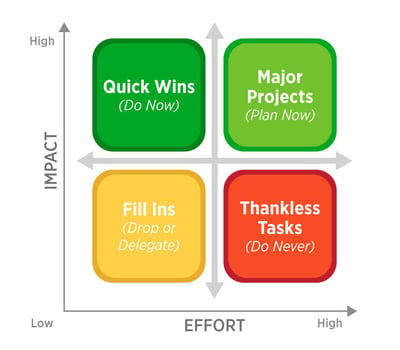
Leaders of the student enrollment revolution, we’re here for you.
With so much planning going on for an enrollment cycle so very in flux, and past trend data not quite so predictive as it used to be, we thought now would be a good time to reboot one of our most popular posts, “How to Say ‘No’ to Ideas That Aren’t Good Enough.”
It should be a helpful tool at a time when focus is essential in the midst of so many #EdTech solutions and platforms for recruitment and enrollment continually seek your attention.
Read on for the 5 questions every leader must ask and every department must answer when presented with new plans – those that seem great, not so great, or maybe just crazy enough to work.
Join us at #Nafsa2022 in Denver where we will be offering up four presentations with a range of partners on everything from innovative influencer marketing to new ways to maximize the talent of your global recruiting agent network. We'll be focusing on the need for flexibility throughout your student recruitment and enrollment efforts. Schedule a meeting with a simple email.
We’re here to help you focus on the initiatives that will produce results and justify that budget.
1. How does this idea support my institution’s goals?
Ideas that lead to actionable strategic initiatives start with this question. Does the idea align with the goals of your institution at large, department, team, etc.? And if so, how? Surprisingly, defining exactly what you are trying to accomplish with an idea and why can be difficult. Often, envisioning the goal and working your way back to the answer can help you parse ideas that align with your goals from those that don’t. It’s the key question that helps dismiss the inevitable (but oh-so shiny) distractions that pop up along the way.
2. How does this idea support my customer’s needs?
Broadly speaking, your customers are your students and their parents — those paying the tuition bills. that your institution sends them. But it’s really important to get specific here.
Within each audience are segmented groups that have their own identifiable needs (think domestic regional, domestic distant, international by country, non-traditional, first-year, undergraduate, graduate, transfer, program of interest, financial capacity, ethnicity…you get the idea). It should be understood that your new idea serves one or more of these specific needs for a specific audience segment.
If you aren’t exactly sure what your students are looking for, we can help you identify student needs and differentiators through our quick, targeted market research projects. Primary rule of marketing: Know thy customer.
3. How does this idea fit into the broader market/my broader plan?
Let’s make one thing very clear — just because everyone else is doing it, does not mean you need to do it, i.e., No, your institution does not need to be on TikTok. The fear of missing out never served anyone well, especially when it comes to making strategic decisions.
Institutional goals and customer needs are first on our list for a reason. Putting those things at the forefront of your decision-making will allow you to cut through the broader market noise and focus on what will drive results for your specific brand. Use your institution’s strategic goals as your measuring stick. Not the goals of your competitors. And definitely not the goals of shiny new platforms.
Another important clarifier: though it feels safe to rely on tactics you’ve used in the past, your data is likely indicating a diminishing return. It’s the nature of the market. (You’ve kept an eye on this, right?) New technology platforms, new staffing structure, new marketing channels, new messaging — these all need to be evaluated. Case in point: How is that student list purchase delivering for you? You know, the one that all of your competitors have also purchased.
When it comes time to evaluate the ideas and options, relying on broad and deep industry expertise, experience, and data are essential. We’re here when you are ready.
4. How much effort does this idea require?
So, you’ve got a handful of brilliant ideas that align with your institution, your students, and the broader market (great!). BUT those brilliant ideas will require time and budget that you don’t have (not so great).
It’s time to get strategic about your prioritization.
A helpful tool when considering your plan of attack is the oft-cited Impact Effort Matrix which can help you quickly and easily visualize where to spend your team’s valuable time and resources to maximize the impact for your business or institution.

- High Impact/Low Effort: These are your “Quick Wins”, the low hanging fruit projects to tackle quickly for maximum results.
- High Impact/High Effort: These are “Major Projects” or larger strategic initiatives with higher resource and planning costs, but costs that you anticipate will produce strong returns (you’ll probably find most of your ideas fall in this category).
- Low Impact/Low Effort and High Effort/Low Impact: These are "Fill Ins" and "Thankless Tasks" filled with things that likely aren’t worth your time.
- Pro Tip: It can’t hurt to keep some "Fill Ins" hanging around your to-do list if you need that quick “check!” rush of accomplishment to keep you and your team going. 😁
While we stand by this tool and regularly recommend it as a resource for strategic enrollment management planning, it should not be used in a vacuum. The reality: humans are notoriously bad at anticipating the actual level of effort required to complete a task, as well as its impact.
This reality brings us to the final question...
5. How will I measure success?
A spark of brilliance turned full-blown transformational strategy lives and dies on a measurable goal. Ask yourself, can the impact of this idea be measured, and if so, how? What kind of results matter and can be directly (or indirectly) attributable to this initiative?
Idea commitment requires specific and timebound metrics to keep you and your team on track. And if you’re struggling to establish success metrics for your idea, you likely still have some work to do on how and where it fits into your institution’s goals. Struggling with the measurement piece is an indicator.
Success metrics can inform that “Impact” axis and your prioritization of ideas (e.g. a 2% lift in conversion rate produced from re-working your existing lead generation form will produce X number of new leads vs. a 5% lift produced from creating a new, really engaging, downloadable content offer.)
And the best part of well-defined success metrics? They can justify your next big idea to leadership come next budget season. And help you know when to celebrate a job well done.
A final tip: Get some perspective
We get it, saying “no” to ideas is often easier said than done, especially when you throw institutional politics into the mix. Your CFO, who has to say “no” to so many things, may have a thing or two to say about this.
Getting an external perspective can prove invaluable to the planning process, especially when it comes with a track record of (measurable) results and deep market knowledge.
We know you and your team have a bunch of brilliant ideas kicking around, and Intead is here to be your sounding board and advisor. So many platforms, student engagement tools, marketing approaches, and digital channels to evaluate. From the quick wins to the long-term projects, we’ll help you develop a plan that justifies your budget every time and delivers results. Be in touch.



